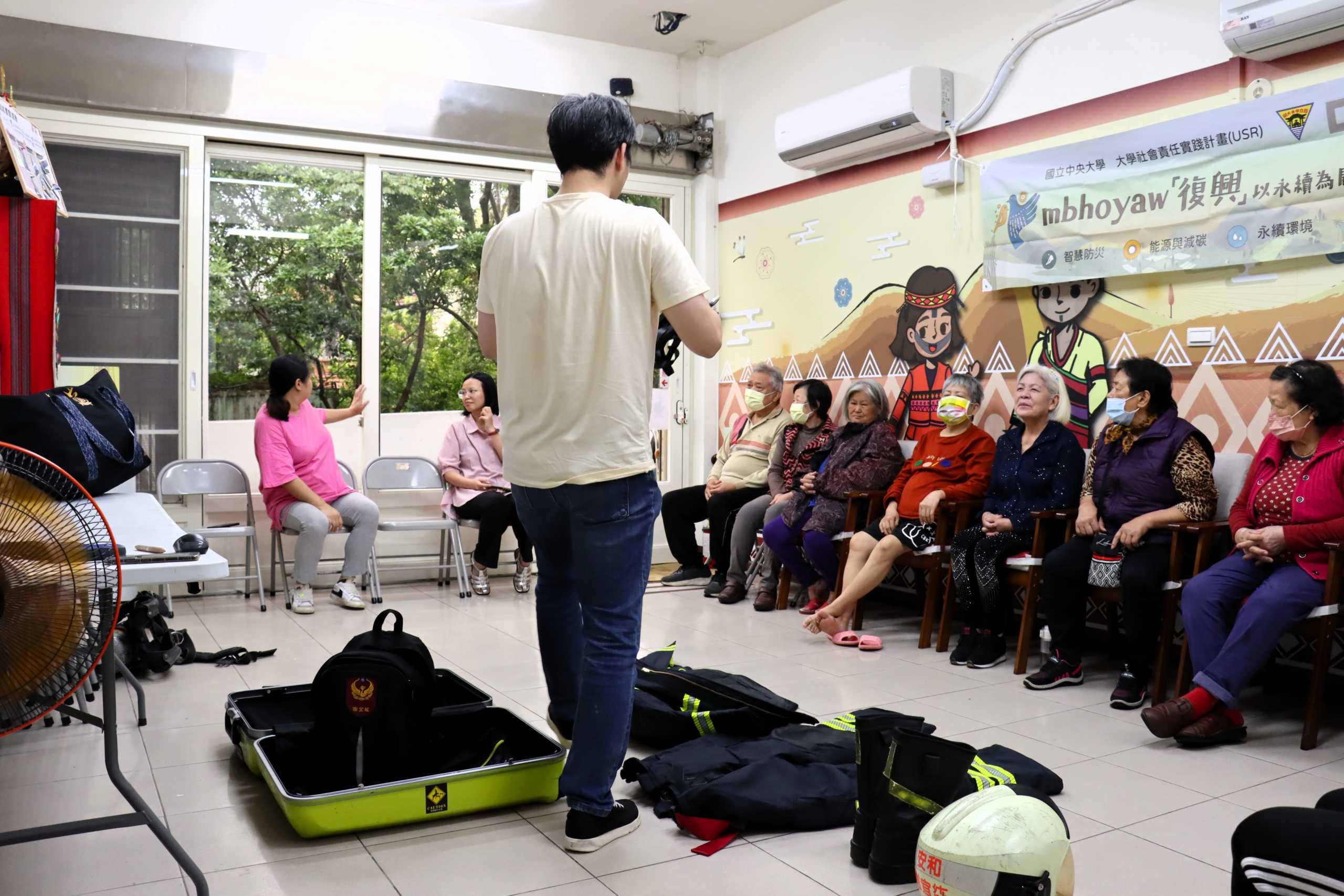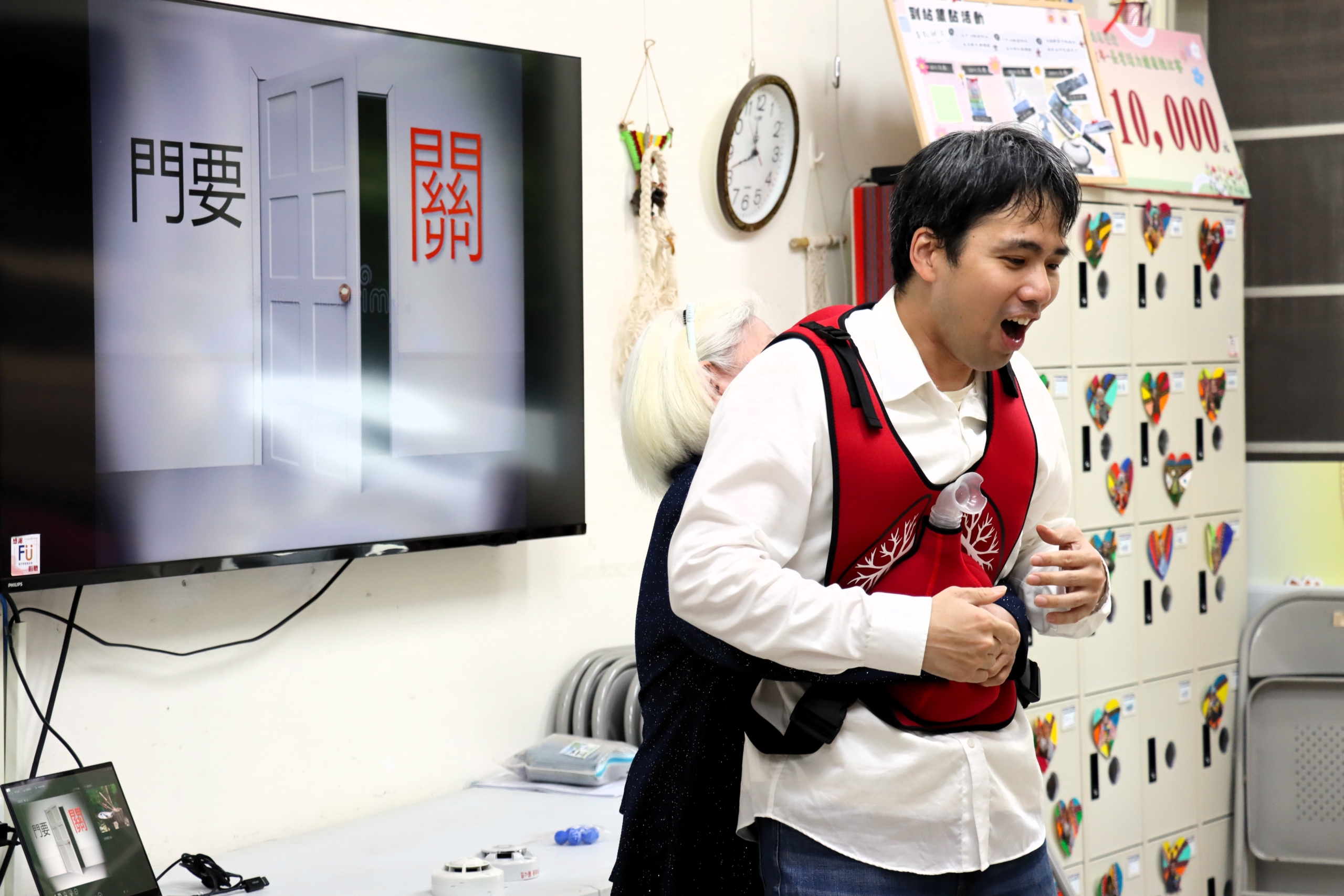A gentle morning rain blanketed the village, and the campus air was thick with dampness. Yet the chill in the air did little to dampen our spirits as we made our way to the Luofu Community Wellness Center for a fire safety education session. During the hour-long ride through familiar, winding mountain roads, the scent of the forest filled the car—soothing and grounding us. When we arrived, the center was still quiet, the elders not yet assembled. Soon, an elderly woman with silver hair pushed open the screen door and stepped inside. She tucked her fabric tote into a locker marked with her photo, her timeworn face lit up with a radiant smile. That warm and simple gesture became my first, unforgettable impression of this mountain gathering place.
The patter of rain mixed with lively voices as our guest instructor, Officer Hsieh, arrived. A firefighter from Taipei, he came towing a suitcase packed with full firefighting gear. Known for spending his personal time traveling to share safety knowledge, Officer Hsieh began by laying out his equipment—fireproof clothing, boots, helmet, and an air tank. Holding up a mismatched pair of fire boots, he joked, “Grandma, Grandpa, did I wear these right?” The room erupted in laughter, and the elders eagerly offered corrections. Moments later, his tone turned serious as he explained how the air tank alters a firefighter’s voice—making it deep and unfamiliar. He shared how, in emergencies, people often panic at the sight of a fully suited firefighter, mistaking them for something alien. As he put on his mask and demonstrated, the room fell silent. When he finally removed the gear, impressions from the mask were still etched on his forehead. The elders nodded, saying they would remember this image and share what they learned with family and friends. As I reviewed the photo of him in his helmet, it struck me: often, the greatest barrier to saving lives is our fear of the unfamiliar.
After introducing the equipment, Officer Hsieh led a visual walkthrough of real fire scenes using slides and colorful picture cards. Each elder was invited to select one or two cards and lay them out on the floor. With each scenario—ranging from kitchen grease fires to post-earthquake damage—he patiently walked everyone through the hazards. These cards passed through hands marked by time, warmed by touch, and infused with lived experience. In this way, fire safety knowledge became something tangible—rooted in the elders’ everyday lives and no longer an abstract concept. Slowly, quietly, awareness took root in the heart of Luofu Village.
As the session neared its close, Officer Hsieh played a video showing how swiftly flames can spread through a room. The clip paused at the moment fire engulfed a sofa. Pointing to his throat, he said, “When fire strikes, the first thing to do isn’t to run. It’s to use this—your voice—to alert others.” He stressed that in moments of panic, people often flee, forgetting that children or pets may still be inside, missing the chance to save them. One by one, the elders stood and practiced shouting warning phrases. Some called out in Mandarin, others in Taiwanese, and still others in Atayal—their native language. The chorus of voices created a layered, multilingual emergency symphony, echoing through the center and embedding the spirit of preparedness into the hills themselves.
The final segment featured a demonstration of the Heimlich maneuver. Officer Hsieh reminded everyone that strength alone isn’t the key—knowledge and swift response are what matter. He invited an elder to the front, guiding him through hand positioning and technique using a model. With support and adjustment, the elder successfully dislodged a simulated obstruction—drawing smiles and applause from the group. It was a fitting, heartfelt conclusion to a meaningful session.
In this mountain village shrouded in mist, we witnessed knowledge come to life—transformed into something visible, memorable, and real. And in sharing these moments, we found ourselves drawn closer to this land and its people, step by step, word by word.
Written by Su, Tzu-Ting
Edited by Li, Ruo-Jia
Photos by Su, Tzu-Ting






